Manitou Mattoc Pro 2 - Review
When the Mattoc Pro first dropped back in 2014 it was a push for the brand back into a territory they hadn’t occupied for some time, with the main competition from the RockShox Pike and Fox 36 being well established in this segment. Despite that fierce competition, the fork was received reasonably well, especially when considering the price-point. Now, two years on, the Mattoc Pro 2 is the updated successor to the original, but the competition remains mostly the same, with the exception of a couple of notable additions; DVO and their Diamond fork being more established and accessible, and the slightly bigger, though still available in a 160mm length, Rockshox Lyrik.
So how does the updated Mattoc compare with the competition, and have the changes resulted in an even better-performing fork?
Mattoc Pro 2 Details
• Intended use: all-mountain, enduro
• Travel: 140, 150, 160 (tested), 170mm (26” only)
• Air-sprung, Dorado Air
• Damper adjustments: low-speed / high-speed compression, rebound, hydraulic bottom out
• IVA air spring volume adjustment system installed
• Option to Upgrade to the IRT volume adjustment system
• Stanchions: 34mm
• Axle size: 15 x 100mm, QR15 or hex-key thru-axle
• Post Mount 180mm
• Weight: 1877 grams (4.14 lb)
• MSRP: $799 USD w/ the IVA assembly installed
• www.manitoumtb.com
• Intended use: all-mountain, enduro
• Travel: 140, 150, 160 (tested), 170mm (26” only)
• Air-sprung, Dorado Air
• Damper adjustments: low-speed / high-speed compression, rebound, hydraulic bottom out
• IVA air spring volume adjustment system installed
• Option to Upgrade to the IRT volume adjustment system
• Stanchions: 34mm
• Axle size: 15 x 100mm, QR15 or hex-key thru-axle
• Post Mount 180mm
• Weight: 1877 grams (4.14 lb)
• MSRP: $799 USD w/ the IVA assembly installed
• www.manitoumtb.com
The Mattoc Pro 2 is available in both a 27.5” wheel size and a 26” version, keeping the “26 ain't dead” posse happy. The 26” model is also available in a 170mm travel option, for the heavy hitters out there. There are no 29” versions of the fork currently available.
For 2016, the Mattoc is available in three outfits; the Comp, Expert and the Pro that we’ve tested here. The chassis of each model is the same, but the damper and the adjustability of them change dependant on the model. In the Pro 2 model tested here, we get the MC2 damper with high- and low-speed compression, as well as rebound adjustments, plus the ability to adjust the bottom out resistance via the Hydraulic Bottom Out dial.
On the spring-side is the DH Air (Dorado) and the Pro 2 version of the fork comes fitted with the IVA (Incremental Volume Adjust) system installed, allowing riders to adjust the air volume with spacers. There is also now an aftermarket upgrade kit available in the form of the IRT (Infinite Rate Tune), granting users even more customizability of their air volume. The fork arrived with the IVA assembly installed, but I also spent an equal amount of time aboard the IRT and both systems are available for all of the older versions of the fork, with the exception of the IRT, which is only available for the Pro and Expert models. The IVA goes for $49.99 USD, and the IRT will set riders back $79.99 USD.
Setup
Initial setup of the Mattoc Pro 2 is straight-forward thanks to the air spring pressure guide included on the back of the left fork lower and the included range of baselines for the damper. After a couple of rides, I popped the IVA from the fork and repositioned the volume spacers to help with how the fork used its travel. A few more rides and I was satisfied with the damper settings as well.
After some time rallying the fork with the IVA adjustment system installed, it was time to mix it up and throw in the IRT assembly. The IRT allows far more customization of the spring, with Manitou claiming a specific focus on the forks mid-stroke while separating it from affecting performance at the bottom-end. They believe that riders want to be able to adjust the feel of the mid-stroke of a fork and that this adds more value than ramp-up adjustability. It’s easy to change the volume adjustment assembly, provided a user is comfortable with a 24mm socket wrench. Once swapped out initial settings are reasonably straight-forward thanks to more recommendations that Manitou provide, but there is a lot of room for customization, with any slight changes in air pressure adjusting the forks behavior considerably.
Performance
When the Mattoc was first set to a point I was happy with, which only took a few rides, it performed reasonably well, but there were a number of nagging elements that had me questioning the fork. It soon became clear that the Mattoc I received had some problems, with some bushing issues being the root of most of my concerns. This problem resulted in a rattle that could be felt when unweighting the front-end, and worse, binding, especially noticeable when cornering in rougher terrain. After a new fork had been sent out, everything was smooth sailing, with none of those issues to be found.
Given the problems with the initial fork, and thanks to some rolling changes that Manitou had made to the valving since the first one was built up, I started the test with exactly the same settings as I had when I finished with the original one. I also went back to the IVA system for the first few weeks. The new fork rode better, and it was now that I could feel how it was intended to function.
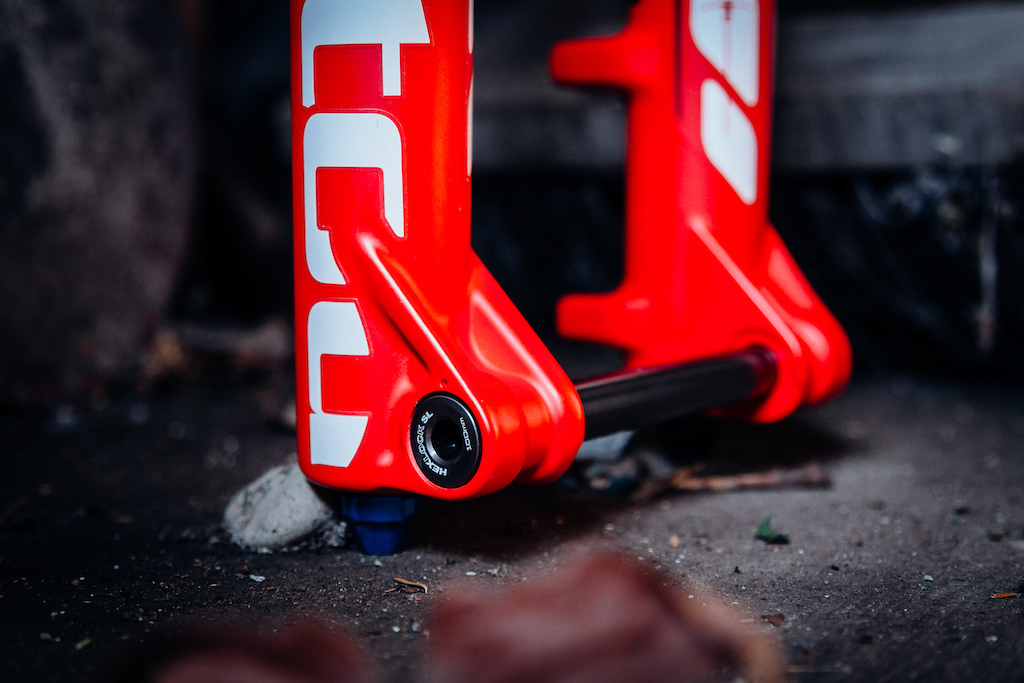
The clean looking hex-key through axle. I opted for this because it takes two seconds to pull out the tool and it's far cleaner than the QR15.
The IVA system works similar to tokens used by Rockshox, with Manitou claiming it to be a more user-friendly way of adjusting the progression of the fork. The updated valving (since Sea Otter) resulted in the fork sitting a little higher in its stroke, something that I was happy about, and it felt better overall on the trail, with smoother use of its travel and better small bump activity. Eventually, the HBO was turned off completely, because of the progression added to the bottom-end with the volume spacers, but they were required to have the fork perform closer to how I prefer through the mid-stroke. With this setup the fork was good, but it still didn’t have the sensitivity of the competition in the top-end, nor did it feel as refined in its use of the travel throughout.
At this point, the timing was right to try out the IRT and really see how it could be set up with incremental changes to the air pressure. The spring is pressurized through the main chamber (Dorado Air) as normal, with the positive and negative chambers filled automatically from one valve. Where the IRT comes into play is outside of these, creating an additional chamber for air within the fork (at the top, just below the crown). More pressure in this chamber is claimed to make for a ride with more support through the mid-stroke, and less pressure should result in a more active mid-stroke. As the fork goes through its travel, this dynamic air piston reacts based on the pressure within the IRT and that pushing up against it from the main chamber. The more it goes into the stroke, the more the positive air chamber’s pressure is said to increase, and as it increases this creates more push against the IRT chamber.
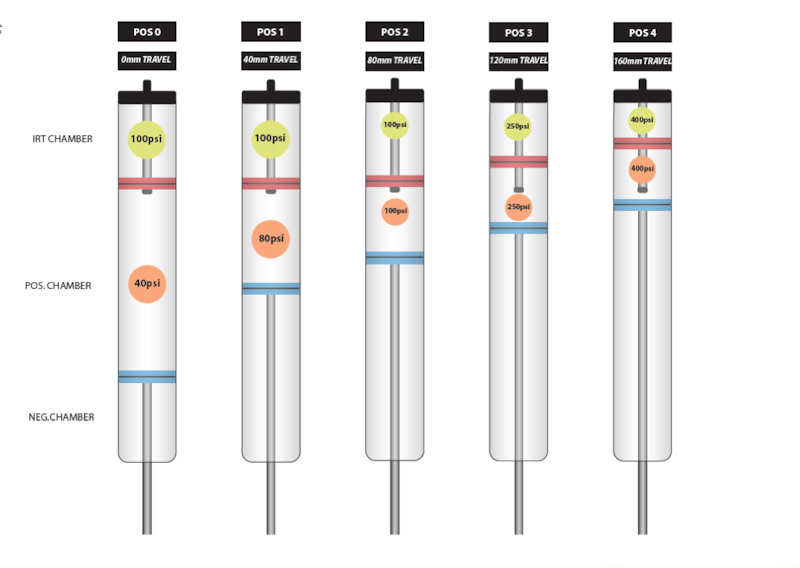
A visual representation of how the IRT dynamic air piston is affected as the fork moves through its travel.
Manitou's clever adaptation of using air for controlling the spring sounds cool and all, but how did it equate to performance on the trail? Initially, I set the fork to the same amount of sag that was being run with the IVA but found it to dive too far into its travel on steeper, rougher terrain and when under heavy braking. More air in the main chamber helped with this, but I found that the mid-stroke still didn’t behave as I would prefer - it still lacked stability, and I was really looking to amend that. This is where the balance of the pressures in the IRT and main chambers begin to do the dance, as any change to the main chamber will affect the IRT, and more pressure in the IRT will affect the way the fork goes through its stroke.
After a few adjustments I got the IRT pressure to a point that was reasonably stable throughout its travel; sensitive enough off the top and consistent through the travel, with the help of one click of HBO for some bottom end support. Throughout this process subtle changes to the damper were also required to help get it to that happy place. In the end, I found the fork to work very well, especially for this price-point, and the amount of adjustability at this tier is quite simply unheard of, even when factoring in the addition of the upgrades that really allows for this. I never had a problem with bottoming the fork out too easily, and the chassis, despite its slimmer profile to the competition, felt reasonably solid. All in for the Pro 2 (which comes with the IVA assembly installed) and the IRT you're looking at less than $800 USD, and that gives you a fork that can be adjusted in an incredible amount of ways by the user.
Issues
After four months of consistent riding on the Mattoc Pro 2 there were zero issues with durability, with the seals doing their job well and the fork remaining as smooth as it was when I first took it out of the box. The problems I had with the first fork never presented themselves with the second one. I did find that under perfect conditions (read, velcro traction) on smooth, machine-built trail and under super hard braking the fork had a little extra flex when clamping down on the 200mm brake rotor, and the axle wanted to fold back under the crown a little. I also had the axle work its way loose after long, aggressive descents, which is something notable.
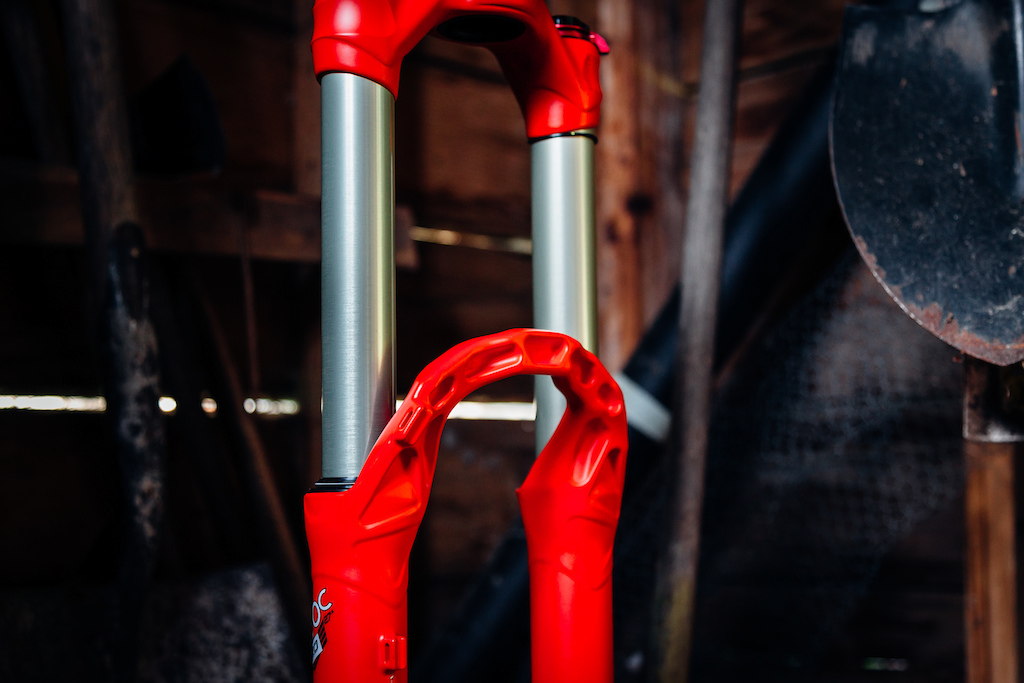
The very noticeable reverse arch has extensive machining to remove some weight. Also, note the cable tie and the need to route through the fork differently to others on the market.
Something that was mentioned in our review of the previous iteration of the fork is the cable routing, which for some won’t be an issue at all, but others may find it unconventional. I managed to get the cable positioned so that it wouldn’t rub the crown as the fork went through its travel, but it was an additional thought during installation that I don't normally have. Functionally it worked fine, and it adds to the different aesthetics of the fork.
Pinkbike’s Take:
 | The updated Mattoc and its added customizability represents a fantastic value for the money, and it cuts incredibly close to the competition in terms of performance for considerably less. Regardless of all of the adjustability, the fork doesn't quite mute some of the smaller trail feedback like the competition does; chatter is more noticeable, especially during long descents. But this is comparing it to forks that cost hundreds more, and in reality, if you're looking for something in this price bracket, there isn't anything out there that offers up as much customization and adjustment. - AJ Barlas |
Author Info:
Must Read This Week
Sign Up for the Pinkbike Newsletter - All the Biggest, Most Interesting Stories in your Inbox
PB Newsletter Signup




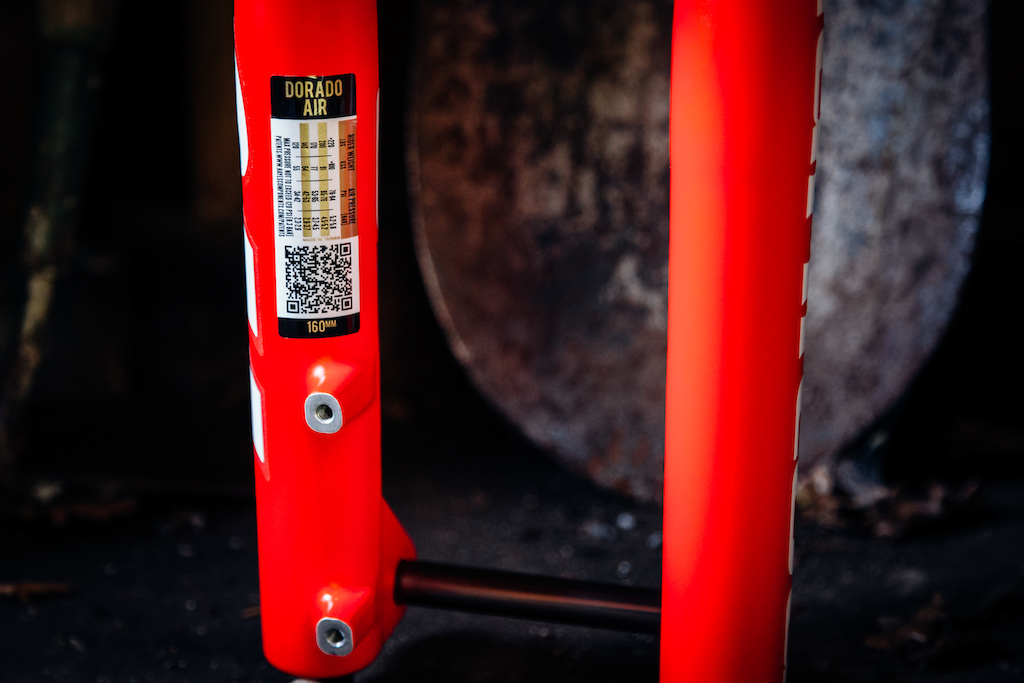

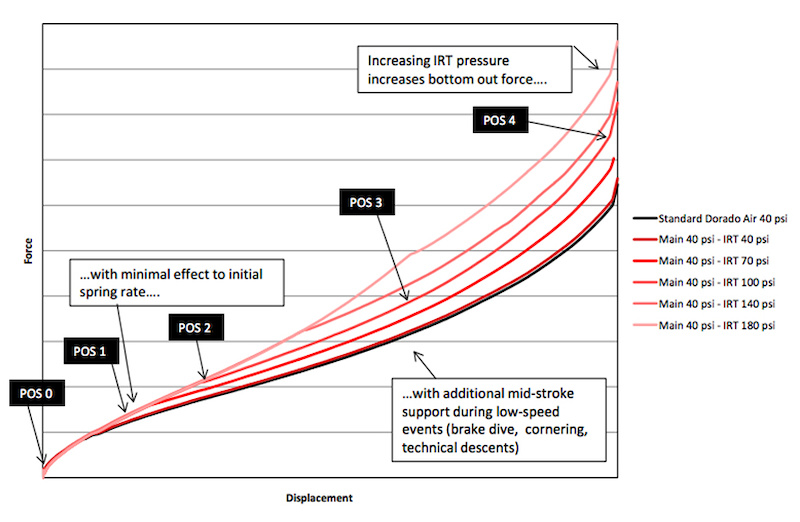

Fatties need love too (Probably, never tried one hahaha)
Manitou just has so much love for wheel sizes.
www.manitoumtb.com/wp-content/uploads/2014/03/Mattoc-Travel-Adjust-Guide.pdf
Bonus Question: Would you really buy a 26" new with all the options out there? As far as I can see, there are very few bikes to choose from, and most of them are old models still in stock.
I know that 2013 GT Fury at Jenson looks sweet and all...
They're probably gonna go straight to 29+ anyway, if you've seen Cam McCaul's 29+ challenge
Can pinkbike do shootout on the new 26 inch forks ? Pike, fox, manitou..
The csu is only different in offset on the 26 and 27.5 Version.height is the same.
You just put 1 spacer into the casting on the air side and exchange 1 part of the hbo on the damping side. That is the complete difference.
ep1.pinkbike.org/p4pb11187004/p4pb11187004.jpg
Normally such a system feels like quite a revolution and makes you realize how much solo air springs suck arse. Noticeably better small bump compliance combined with more midstroke support. Most people run less sag on such a system because of the heavily increased mid stroke support and still run higher in the travel when it counts. Big deal imo. Stating pressures would be helpful.
Also I am missing a mention of the wide tuning range (internally) and Manitou's excellent guidelines how to adapt shimstacks in their forks. In no time you can adapt the damping to your likings (speaking of experience with a Manitou Tower). So yeah, to find out the real potential of the fork this review needs to be way more scientific and less vague in the detail...Something I unfortunately see with 90% of reviews everywhere...
A few additional flaws I'd like to note: 1) I've found that all of my settings (rebound, high/low speed, HBO) are turned completely OFF. It almost makes me wonder if they should further tweak the damper to accommodate the spring curve? 2) the fork is incredibly sensitive to pressure changes. Just 2-3 PSI (the amount that is lost when removing the pump) can have an impact. 3) I run this fork at the bike park (Trestle/Keystone) and after a day of DH performance can degrade slightly. It's a problem with air migration that is mitigated by letting the air out of both chambers, compressing the fork, then re-inflating. 4) The IRT is not for amateurs. Keep it stock if you are not prepared to spend 5-10 rides getting it dialed.
Finally, I've had the chance to ride back/to/back with the Pike and the Mattoc wins in all categories except low-speed, rocky sections where the Pike is just a bit more fluid. Both great options but given what you can find a Mattoc for online it's a no-brainer...
I had a Manitou Tower Pro on my 29'er and it was an excellent fork.
Its a real shame we don't see / hear much about Manitou any more, especially here in the UK where the distributor is Hotlines (owned by Chain Reacton Cycles) which is why you don't see Hayes Bicycle Group products in hardly any bike shops
Competitive price,
Great looks,
And comes in 26"!
You see that Fox, it is possible.
In reality, fabricated "disciplines" aside, the Mattoc competes with the 34 and Pike, NOT the 36 and Lyrik. Those last two are significantly stiffer forks made for AM/Enduro while the Mattoc/34/Pike excel in Trail applications. I support anyone's right to run the fork they want on whatever bike they ride, but comparing a Mattoc/34/Pike to a Lyrik/36 is not going to go well.
I will say however that while the Pike is certainly a bit stiffer than the 2013-15 34, the new 34 is at least on par, if not maybe a smidge stiffer than the pike, especially in 29" form. They really do compare very well.
I guess I should have put more emphasis on the last sentence of my comment - "I support anyone's right to run the fork they want on whatever bike they ride, but comparing a Mattoc/34/Pike to a Lyrik/36 is not going to go well.". That is really my overriding point.
Pinched bolt axle and diameter, interface with hub, tight tolerances and length/overlapping of bushings/stanchions, thickness of crown and overlapping of crown/fork pivot did.
Pike, Lyrics and boxxer got the same stanchion diameter but that and a charger damper are the only common points.
If these parameters are achieved in the right way in the Mattoc, it would be more rigid than a pike, no matter the stanchions diameter or lowers thickness/design.
I own a 36 2016 with 20mm axle, a 34 2014 (1st gen) with 15mm QR and a Pike, all 27.5, and the pike is by far the most flexier on both frontal and torsionnal rigidity plan.
The 0.2 kg penalty of the 36 and 34 totally worth it.
When I talk about a 34mm fork vs. 35mm and 36mm forks, i'm not trying to say that because of the stanchion diameter, they do not compare. I'm talking about everything else that goes along with each stanchion size - i.e. appropriately sized and sculpted lowers and crown, weight reduction measures, and appropriate bushing overlap. All of those factors change commensurately with the change in stanchion diameter since no manufacturer wants their 34mm fork to weigh more than the competitor's 36mm fork.
You clearly don't even know what flex is...so, stfu...
www.pinkbike.com/photo/13077435
Also, you don't run the brake line between the crown and the reverse arch, it wraps around the front of the headtube and behind, below the downtube, that lines it up directly with the first tab on the arch. It's been done that way since 2002.
I love my Mattoc. It came with my bike in August 2015. Could be stiffer, and even with the 2016 internals (warranty issue) it has a little bit of Dorado effect (~5mm after three days in a bikepark).
Needs some care though regularly.
The steerer tube doesnt hold the stem very well, I had to overtighten the screws on the stem to get it tight. You dont want a twisting stem/bar when dropping in..^^
I did find my Mattoc from the factory had too much fluid in the damper, leading to hydraulic lock out (which at first I attributed to the bottom out control).
Very easy to service which is a bonus for me.
For information, this is an article I wrote years ago about how suspension works
ride.io/news/how-front-suspension-works
enduro-mtb.com/en/best-160-mm-mtb-fork-can-buy/4
enduro-mtb.com/en/best-160-mm-mtb-fork-can-buy/12
You never get a second chance at establishing a good FIRST impression.
If they can pump out some proper Hayes brakes and get their ass of that PeteSpeed patent (acquired from BeOne but never used) and make it work, they might become an OEM player as big as SRAM. They've got Answer components, Hayes brakes, PeteSpeed gearing and Manitou suspension. Should be good.